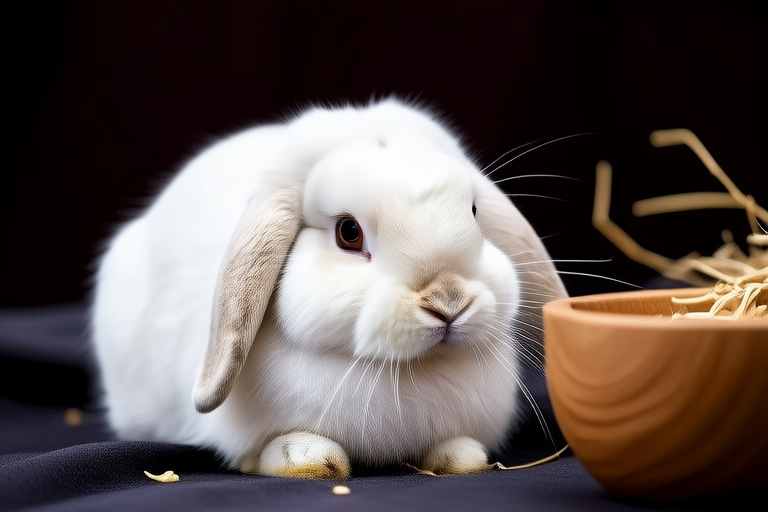Meet the Enigmatic Hotot Rabbit: A Complete Care Guide
The Hotot rabbit is a breed that captivates the hearts of many due to its unique appearance and enigmatic charm. Originating from France, this breed was developed by Eugène Émile Oudry in the early 20th century. The Hotot’s distinctive white fur, framed by a striking black or blue ring around each eye, makes it stand out among other breeds. This captivating feature has earned it the nickname ‘the rabbit with the mascara.’ Despite its popularity among enthusiasts, the Hotot remains relatively rare, adding to its allure.
Dietary Requirements
A balanced diet is crucial for maintaining the health and vitality of your Hotot rabbit. Their diet should primarily consist of high-quality hay, which aids digestion and provides essential nutrients. Fresh vegetables, such as leafy greens like kale, spinach, and romaine lettuce, should be offered daily but in moderation to avoid digestive upset. Fruits can be given occasionally as treats but should not form part of the regular diet due to their sugar content.
Commercial rabbit pellets provide necessary vitamins and minerals and should be available in limited quantities. It’s important to choose pellets specifically formulated for rabbits to ensure they receive the correct balance of nutrients. Additionally, always have access to clean, fresh water, as dehydration can lead to serious health issues.
Housing Requirements
Creating a suitable living environment for your Hotot rabbit is vital for its comfort and well-being. An indoor cage is recommended to protect them from outdoor predators and extreme weather conditions. The cage should be spacious enough to allow the rabbit to stretch out fully and move around comfortably. For a medium-sized Hotot, a minimum cage size of 36 inches long, 18 inches wide, and 24 inches high is advisable.
The flooring of the cage should be soft yet non-abrasive, such as straw or fleece-lined mats, to prevent sore hocks, a common condition in rabbits. Good ventilation is also essential, so ensure there are adequate air holes in the cage. Providing hiding spots, such as cardboard boxes or tunnels, will help your rabbit feel secure and stimulate natural behaviors.
In addition to the indoor cage, it’s beneficial to have a safe outdoor area where your Hotot can explore and play under supervision. Ensure the area is enclosed securely to prevent escapes and dangers.
Exercise Needs
Rabbits are naturally active animals that require ample opportunity for physical activity. Regular exercise helps maintain muscle tone, promotes good cardiovascular health, and reduces the risk of obesity. Allow your Hotot at least three hours of supervised playtime outside its cage each day. This time can be spent in a rabbit-proofed room or a designated play area.
Interactive toys, such as chew toys made from untreated wood or hay balls, encourage mental stimulation and prevent boredom. Providing ramps or platforms within the play area allows for vertical exploration, mimicking their natural behavior in the wild.
Grooming Tips
Maintaining the Hotot’s luxurious coat requires regular grooming to keep it healthy and free from mats. Brush your rabbit gently with a soft bristle brush several times a week, paying special attention to areas prone to matting, such as behind the ears and under the chin. During shedding seasons, more frequent brushing may be necessary.
Bathing should only be done when absolutely necessary, as it can disrupt the natural oils in the rabbit’s skin. If bathing is required, use a gentle, rabbit-safe shampoo and ensure the rabbit is thoroughly dried afterward to prevent chills. Trimming nails regularly is also important to prevent overgrowth and discomfort.
Common Health Issues
Despite their hardiness, Hotot rabbits are susceptible to certain health problems. One of the most common issues is dental disease, which can result from improper diet or genetics. Signs of dental problems include weight loss, reluctance to eat, and drooling. Regular veterinary check-ups can help catch these issues early.
Sore hocks, caused by prolonged pressure on the back feet, can be prevented by providing soft bedding and encouraging regular movement. Gastrointestinal stasis, a potentially life-threatening condition, occurs when the digestive system slows down or stops. Symptoms include lethargy, decreased appetite, and infrequent stool production. Immediate veterinary attention is crucial if you suspect gastrointestinal stasis.
Other common ailments include respiratory infections, which can manifest as sneezing, runny nose, or labored breathing. Ensuring proper ventilation and minimizing stress are key preventive measures.
Bonding and Training
Bonding with your Hotot rabbit is a rewarding experience that strengthens the bond between you and your pet. Spend quality time together each day, offering gentle handling and positive reinforcement through treats and praise. Rabbits are intelligent creatures and can learn simple commands and tricks with patience and consistency.
To train your Hotot, start by establishing a routine and using clicker training techniques. Clicker training involves using a small handheld device that emits a clicking sound to mark desired behaviors. When the rabbit performs a desirable action, such as coming to you on command, click the device and immediately offer a treat. Over time, the rabbit will associate the click with the reward and learn to repeat the behavior.
It’s important to note that rabbits have distinct personalities, and some may be more receptive to training than others. Be patient and respect your rabbit’s boundaries. Avoid forceful methods, as they can cause stress and fear.
The enigmatic Hotot rabbit is a fascinating breed that combines beauty with intelligence. While caring for a Hotot requires dedication and commitment, the rewards are immeasurable. By understanding their dietary needs, providing appropriate housing and exercise, maintaining their grooming, and addressing any health concerns promptly, you can ensure your Hotot leads a happy and healthy life. With proper bonding and training, these charming rabbits can become cherished companions, bringing joy and companionship into your home.
